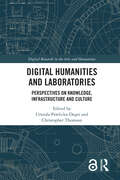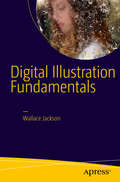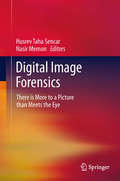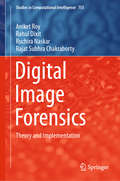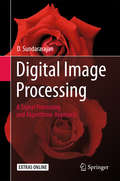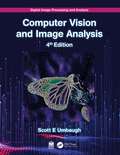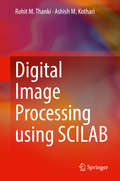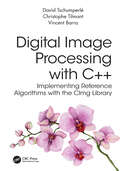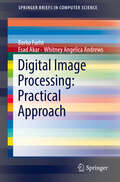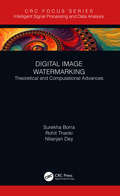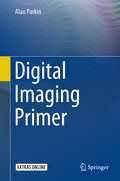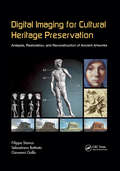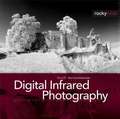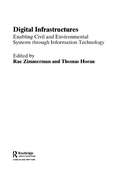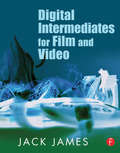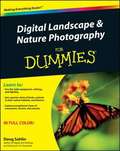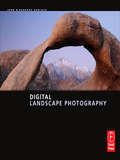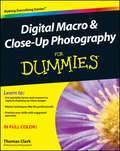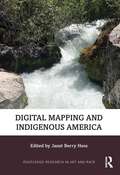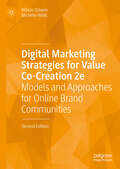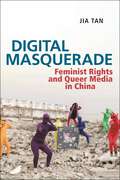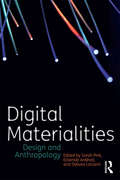- Table View
- List View
Digital Humanities and Laboratories: Perspectives on Knowledge, Infrastructure and Culture (ISSN)
by Urszula Pawlicka-Deger Christopher ThomsonDigital Humanities and Laboratories explores laboratories dedicated to the study of digital humanities (DH) in a global context and contributes to the expanding body of knowledge about situated DH knowledge production.Including a foreword by David Berry and contributions from a diverse, international range of scholars and practitioners, this volume examines the ways laboratories of all kinds contribute to digital research and pedagogy. Acknowledging that they are emerging amid varied cultural and scientific traditions, the volume considers how they lead to the specification of digital humanities and how a locally situated knowledge production is embedded in the global infrastructure system. As a whole, the book consolidates the discussion on the role of the laboratory in DH and brings digital humanists into the interdisciplinary debate concerning the notion of a laboratory as a critical site in the generation of experimental knowledge. Positioning the discussion in relation to ongoing debates in DH, the volume argues that laboratory studies are in an excellent position to capitalize on the theories and knowledge developed in the DH field and open up new research inquiries.Digital Humanities and Laboratories clearly demonstrates that the laboratory is a key site for theoretical and critical analyses of digital humanities and will thus be of interest to scholars, students and practitioners engaged in the study of DH, culture, media, heritage and infrastructure.
Digital Humanities and the Lost Drama of Early Modern England: Ten Case Studies (Studies in Performance and Early Modern Drama)
by Matthew SteggleThis book establishes new information about the likely content of ten lost plays from the period 1580-1642. These plays’ authors include Nashe, Heywood, and Dekker; and the plays themselves connect in direct ways to some of the most canonical dramas of English literature, including Hamlet, King Lear, The Changeling, and The Duchess of Malfi. The lost plays in question are: Terminus & Non Terminus (1586-8); Richard the Confessor (1593); Cutlack (1594); Bellendon (1594); Truth's Supplication to Candlelight (1600); Albere Galles (1602); Henry the Una (c. 1619); The Angel King (1624); The Duchess of Fernandina (c. 1630-42); and The Cardinal's Conspiracy (bef. 1639). From this list of bare titles, it is argued, can be reconstructed comedies, tragedies, and histories, whose leading characters included a saint, a robber, a Medici duchess, an impotent king, at least one pope, and an angel. In each case, newly-available digital research resources make it possible to interrogate the title and to identify the play's subject-matter, analogues, and likely genre. But these concrete examples raise wider theoretical problems: What is a lost play? What can, and cannot, be said about objects in this problematic category? Known lost plays from the early modern commercial theatre outnumber extant plays from that theatre: but how, in practice, can one investigate them? This book offers an innovative theoretical and practical frame for such work, putting digital humanities into action in the emerging field of lost play studies.
Digital Identity and Everyday Activism: Sharing Private Stories With Networked Publics (Palgrave Studies in Communication for Social Change)
by Sonja VivienneThis book reinvigorates the space between scholarly texts on self-representation, voice and agency and practical field-guides to community media and digital storytelling. It offers reflection on the ethical praxis of co-creative media, and an indispensable suite of digitally savvy representation strategies, pertinent to modern people everywhere.
Digital Illustration Fundamentals
by Wallace JacksonThis fun, concise, fullcolor book introduces the fundamentals of digital illustration, and covershow to develop and optimize these types of scalable vector graphics (SVG) usingInkscape 0. 91 or later. It also covers concepts central to digital paintingusing the Corel Painter 2016 professional digital painting and illustrationpaid software package, which also has a free trial version, and a discount forpurchasers of this book. The book builds uponthe foundational concepts of vector graphics and the SVG format, and gets moreadvanced as chapters progress, covering what vector new media formats, and SVGcommands and SVG filters, are best for use with Android Studio, Java 8, JavaFX,iOS, Kindle Fire and HTML5. The book covers key factors regarding the datafootprint optimization work process, and why data footprint optimization isimportant, and covers programming languages used for digital illustration, andpublishing platforms which support digital illustration, and how to assimilatethese into your digital illustration and digital painting content productionpipelines and workflow. You will learn: The terminology of vector imaging and digital illustration What comprises a digital illustration 2D modeling and rendering pipeline Concepts and principles behind digital illustration content production How to install and utilize 64-bit Inkscape 0. 91 for Windows, Mac OSX and Linux Concepts behind spline curves, strokes, fills, patterns and rendering Digital illustration data formats and data footprint optimization Audience Primary: Artists, Illustrators, Website Developers, Flash Developers, User Interface Designers, Digital Signage Content Developers, e-Learning Content Creators, eBook Authors. Secondary: Android Developers, iOS Developers, Multimedia Producers, Rich Internet Application (RIA) Programmers, Game Designers, Teachers, Educators.
Digital Image Forensics
by Husrev Taha Sencar Nasir MemonPhotographic imagery has come a long way from the pinhole cameras of the nineteenth century. Digital imagery, and its applications, develops in tandem with contemporary society's sophisticated literacy of this subtle medium. This book examines the ways in which digital images have become ever more ubiquitous as legal and medical evidence, just as they have become our primary source of news and have replaced paper-based financial documentation. Crucially, the contributions also analyze the very profound problems which have arisen alongside the digital image, issues of veracity and progeny that demand systematic and detailed response: It looks real, but is it? What camera captured it? Has it been doctored or subtly altered? Attempting to provide answers to these slippery issues, the book covers how digital images are created, processed and stored before moving on to set out the latest techniques for forensically examining images, and finally addressing practical issues such as courtroom admissibility. In an environment where even novice users can alter digital media, this authoritative publication will do much so stabilize public trust in these real, yet vastly flexible, images of the world around us.
Digital Image Forensics: Theory and Implementation (Studies in Computational Intelligence #755)
by Rajat Subhra Chakraborty Aniket Roy Rahul Dixit Ruchira NaskarThis book discusses blind investigation and recovery of digital evidence left behind on digital devices, primarily for the purpose of tracing cybercrime sources and criminals. It presents an overview of the challenges of digital image forensics, with a specific focus on two of the most common forensic problems. The first part of the book addresses image source investigation, which involves mapping an image back to its camera source to facilitate investigating and tracing the source of a crime. The second part of the book focuses on image-forgery detection, primarily focusing on “copy-move forgery” in digital images, and presenting effective solutions to copy-move forgery detection with an emphasis on additional related challenges such as blur-invariance, similar genuine object identification, etc. The book concludes with future research directions, including counter forensics. With the necessary mathematical information in every chapter, the book serves as a useful reference resource for researchers and professionals alike. In addition, it can also be used as a supplementary text for upper-undergraduate and graduate-level courses on “Digital Image Processing”, “Information Security”, “Machine Learning”, “Computer Vision” and “Multimedia Security and Forensics”.
Digital Image Processing
by D. SundararajanThis book offers readers an essential introduction to the fundamentals of digital image processing. Pursuing a signal processing and algorithmic approach, it makes the fundamentals of digital image processing accessible and easy to learn. It is written in a clear and concise manner with a large number of 4 x 4 and 8 x 8 examples, figures and detailed explanations. Each concept is developed from the basic principles and described in detail with equal emphasis on theory and practice. The book is accompanied by a companion website that provides several MATLAB programs for the implementation of image processing algorithms. The book also offers comprehensive coverage of the following topics: Enhancement, Transform processing, Restoration, Registration, Reconstruction from projections, Morphological image processing, Edge detection, Object representation and classification, Compression, and Color processing.
Digital Image Processing and Analysis: Computer Vision and Image Analysis
by Scott E UmbaughComputer Vision and Image Analysis, focuses on techniques and methods for image analysis and their use in the development of computer vison applications. The field is advancing at an ever increasing pace, with applications ranging from medical diagnostics to space exploration. The diversity of applications is one of the driving forces that make it such an exciting field to be involved in for the 21st century. This book presents a unique engineering approach to the practice of computer vision and image analysis, which starts by presenting a global model to help gain an understanding of the overall process, followed by a breakdown and explanation of each individual topic. Topics are presented as they become necessary for understanding the practical imaging model under study, which provides the reader with the motivation to learn about and use the tools and methods being explored. The book includes chapters on image systems and software, image analysis, edge, line and shape detection, image segmentation, feature extraction and pattern classification. Numerous examples, including over 500 color images are used to illustrate the concepts discussed. Readers can explore their own application development with any programming languages, including C/C++, MATLAB®, Python, and R, and software is provided for both the Windows/C/C++ and MATLAB®environments. The book can be used by the academic community in teaching and research, with over 700 PowerPoint Slides and a complete Solutions Manual to the over 150 included problems. It can also be used for self-study by those involved with developing computer vision applications, whether they are engineers, scientists or artists. The new edition has been extensively updated and includes numerous problems and programming exercises that will help the reader and student to develop their skills.
Digital Image Processing using SCILAB
by Rohit M. Thanki Ashish M. KothariThis book provides basic theories and implementations using SCILAB open-source software for digital images. The book simplifies image processing theories and well as implementation of image processing algorithms, making it accessible to those with basic knowledge of image processing. This book includes many SCILAB programs at the end of each theory, which help in understanding concepts. The book includes more than sixty SCILAB programs of the image processing theory. In the appendix, readers will find a deeper glimpse into the research areas in the image processing.
Digital Image Processing with C++: Implementing Reference Algorithms with the CImg Library
by David Tschumperle Christophe Tilmant Vincent BarraDigital Image Processing with C++ presents the theory of digital image processing, and implementations of algorithms using a dedicated library. Processing a digital image means transforming its content (denoising, stylizing, etc.), or extracting information to solve a given problem (object recognition, measurement, motion estimation, etc.). This book presents the mathematical theories underlying digital image processing, as well as their practical implementation through examples of algorithms implemented in the C++ language, using the free and easy-to-use CImg library. Chapters cover in a broad way the field of digital image processing and proposes practical and functional implementations of each method theoretically described. The main topics covered include filtering in spatial and frequency domains, mathematical morphology, feature extraction and applications to segmentation, motion estimation, multispectral image processing and 3D visualization. Students or developers wishing to discover or specialize in this discipline, teachers and researchers wishing to quickly prototype new algorithms, or develop courses, will all find in this book material to discover image processing or deepen their knowledge in this field.
Digital Image Processing: An Algorithmic Approach with MATLAB (Chapman & Hall/CRC Textbooks in Computing)
by Uvais Qidwai C.H. ChenAvoiding heavy mathematics and lengthy programming details, Digital Image Processing: An Algorithmic Approach with MATLAB presents an easy methodology for learning the fundamentals of image processing. The book applies the algorithms using MATLAB, without bogging down students with syntactical and debugging issues.One chapter can typically be compl
Digital Image Processing: Practical Approach (SpringerBriefs in Computer Science)
by Borko Furht Esad Akar Whitney Angelica AndrewsThe SpringerBrief covers fundamentals of digital image processing including image concept, image file formats, creating user interfaces and many practical examples of processing images using C++ and Java. These practical examples include among other creating image histograms, performing lossless image compression, detecting change in colors, similarity-based image retrieval and others. All practical examples are accompanied with an explanation how to create programs and the obtained results. This SpringerBrief can be very useful for the undergraduate courses on image processing, providing students with the basic tools in image analysis and processing. Practitioners and researchers working in this field will also find this research useful.
Digital Image Watermarking: Theoretical and Computational Advances (Intelligent Signal Processing and Data Analysis)
by Nilanjan Dey Rohit Thanki Surekha BorraThe Book presents an overview of newly developed watermarking techniques in various independent and hybrid domains <P><P>Covers the basics of digital watermarking, its types, domain in which it is implemented and the application of machine learning algorithms onto digital watermarking <P><P>Reviews hardware implementation of watermarking <P><P>Discusses optimization problems and solutions in watermarking with a special focus on bio-inspired algorithms <P><P>Includes a case study along with its MATLAB code and simulation results
Digital Imaging Primer
by Alan ParkinDigital Imaging targets anyone with an interest in digital imaging, professional or private, who uses even quite modest equipment such as a PC, digital camera and scanner, a graphics editor such as PAINT, and an inkjet printer. Uniquely, it is intended to fill the gap between the highly technical texts for academics (with access to expensive equipment), and the superficial introductions for amateurs. The four-part treatment spans theory, technology, programs and practice. Theory covers integer arithmetic, additive and subtractive color, greyscales, computational geometry, and a new presentation of discrete Fourier analysis; Technology considers bitmap file structures, scanners, digital cameras, graphic editors, and inkjet printers; Programs develops several processing tools for use in conjunction with a standard Paint graphics editor and supplementary processing tools; Practice discusses 1-bit, greyscale, 4-bit, 8-bit, and 24-bit images for the practice section. Relevant QBASIC code is supplied an accompanying CD and algorithms are listed in the appendix. Readers can attain a level of understanding and the practical insights to obtain optimal use and satisfaction from even the most basic digital-imaging equipment.
Digital Imaging for Cultural Heritage Preservation: Analysis, Restoration, and Reconstruction of Ancient Artworks (Digital Imaging and Computer Vision)
by Filippo StancoThis edition presents the most prominent topics and applications of digital image processing, analysis, and computer graphics in the field of cultural heritage preservation. The text assumes prior knowledge of digital image processing and computer graphics fundamentals. Each chapter contains a table of contents, illustrations, and figures that elucidate the presented concepts in detail, as well as a chapter summary and a bibliography for further reading. Well-known experts cover a wide range of topics and related applications, including spectral imaging, automated restoration, computational reconstruction, digital reproduction, and 3D models.
Digital Infrared Photography
by Cyrill HarnischmacherTo record the "invisible light " has always been an intriguing and fascinating experiment. The infrared part of the light spectrum is outside the range of what the human eye can see, but with a digital camera, we are able to record only this "invisible light " while blocking the "visible " part. The results are often unusual, yet beautiful, renderings of otherwise fairly common scenes. Since as far back as the 1960 's artists have experimented with analog infrared photography, as seen on the album covers of Jimi Hendrix and Frank Zappa. But as we enter the digital age, new equipment and technology has opened up the exciting world of infrared photography to all. This compact guide to infrared photography shows the beauty of infrared imagery, but also teaches how to shoot these images with your digital camera. The book provides the basic theoretical background, some information on cameras, filters and equipment, and lots of guidance on how to do infrared photography. This beautifully designed and illustrated book is the perfect companion for the aspiring photographer wanting to explore new photographic territories.
Digital Infrastructures: Enabling Civil and Environmental Systems through Information Technology (Networked Cities Series)
by Thomas Horan Rae ZimmermanAn invisible network of digital technology systems underlies the highly visible networks of roads, waterways, satellites, and power-lines. Increasingly, these systems are becoming the "infrastructure's infrastructure," providing a crucial array of data on network demand, performance, reliability, and security. Digital Infrastructures presents an interdisciplinary analysis of the technological systems that envelop these networks. The book balances analyses of specific civil and environmental infrastructures with broader policy and management issues, including the challenges of using IT to manage these critical systems under crises conditions.
Digital Intermediates for Film and Video
by Jack JamesThe Digital Intermediate process (DI), or conversion of film to digital bits and then back to film again, has great potential to revolutionize the postproduction process. The skill set to photochemically process a movie and pop it into a canister for the postal service to send around to all of the movie houses and the skill set to digitally master and create a file that is distributed globally via the Internet and satellites are completely different. One of these entirely new processes is that of the digital intermediate. The DI has tremendous advantages, ranging from improved quality (first "print" is as good as the last) to cost savings (no re-mastering) to digital distribution (bits and bytes: no film in canisters). The DI influences everything from on set production to the delivery of content to consumers and everything in between. Digital Intermediates for Film and Video teaches the fundamental concepts and workflow of the digital intermediate process. Covers basics of film first, and then introduces the digital world--including a tutorial on digital images, asset management, online editing, color correction, restoration, film and video output, mastering and quality control. Jack's clear and easy-to-follow explainiation of Hollywood buzz words and components facilitates the spill over to anyone who has a vested interest in the quality and cost of the movie.
Digital Landscape & Nature Photography For Dummies
by Doug SahlinStep-by-step instruction on creating beautiful nature and landscape portraits This eye-popping guide walks you through the nitty gritty of how to take memorable and stunning landscape and nature photos. Packed with constructive advice and a good dose of friendly handholding, this full-color and extra large-trim beginner guide escorts you through the basics of photography and explains how to apply those fundamentals when taking high-quality photos. Walks you through the basics of photography and details how you can apply those skills to nature and landscape photography Zeroes in on ways to sharpen your skills by adjusting exposure, composition, and lighting in order to get the best results Explores the most popular landscape themes and describes how to capture them, including forests, mountains, crashing waves, and sunsets Shares tips on processing photos, making common repairs, and finding inspiration Digital Landscape and Nature Photography For Dummies investigates the most popular nature themes and describes how to capture them, including birds, animals in the wild, animals in captivity, flowers, and insects.
Digital Landscape Photography (Digital Photography Ser.)
by John and GerlachPhotographing landscape with a film camera is different than with a digital camera. There are several books on the market that cover landscape photography, but none of them are specifically for the digital photographer. This book is what you are looking for! Digital Landscape Photography covers:* equipment such as accessories and lenses* exposure from shutter speed to common mistakes* shooting * light and its importance* composing your perfect photo* printing* and a special section on specific subjects such as waterfalls and sunrisesDigital Landscape Photography, written by experts that have been shooting outdoors for decades, is a fresh look at current ways to shoot landscapes by making the most of digital format.
Digital Macro and Close-Up Photography For Dummies
by Thomas ClarkMaster macro techniques and capture brilliant up-close photosMacro photography uses specialty lenses and advanced digital cameras to capture stunning up-close images. This book helps you understand the nuances of macro techniques so you can take unique and remarkable close-up digital photos. Equipment recommendations, helpful tips, and coverage of specialized elements that are exclusive to macro photography all aim to make you more savvy and comfortable with macro and close-up techniques. In addition, the easy-to-follow steps and suggested exercises go a long way to make you more familiar with your camera's capabilities so that you can take fantastic photos.Introduces the techniques of macro photography and explores how to capture stunning close-up digital photosReviews using macro lenses, extension tubes, reversing rings, and other camera equipment and accessoriesShares tips for exposure and lighting techniques in the macro formatAddresses depth of field, working distance, and framing when shootingCovers where to find subjects to shoot and setting up your macro studioWith full-color examples and technique comparisons, this fun and friendly book presents step-by-step guidance for taking your close-up photography skills to the next level.
Digital Mapping and Indigenous America (Routledge Research in Art and Race)
by Janet Berry HessEmploying anthropology, field research, and humanities methodologies as well as digital cartography, and foregrounding the voices of Indigenous scholars, this text examines digital projects currently underway, and includes alternative modes of "mapping" Native American, Alaskan Native, Indigenous Hawaiian and First Nations land. The work of both established and emerging scholars addressing a range of geographic regions and cultural issues is also represented. Issues addressed include the history of maps made by Native Americans; healing and reconciliation projects related to boarding schools; language and land reclamation; Western cartographic maps created in collaboration with Indigenous nations; and digital resources that combine maps with narrative, art, and film, along with chapters on archaeology, place naming, and the digital presence of elders. This text is of interest to scholars working in history, cultural studies, anthropology, Native American studies, and digital cartography.
Digital Marketing Strategies for Value Co-Creation 2e: Models and Approaches for Online Brand Communities
by Wilson Ozuem Michelle WillisAmidst growing conceptual developments in the areas of value co-creation and digital marketing, the importance of Online Brand Communities (OBCs) has emerged to reinforce strategies. This book provides an introduction to a range of broad and debatable conceptual perspectives and mechanisms on the subject of OBC. Focusing on contemporary digital marketing issues, it offers a comprehensive examination of consumers’ response to active engagement in such communities. Building on the very successful original publication, this thoroughly revised second edition includes two new chapters on data-driven segmentation and artificial intelligence and customer engagement. The book balances theory with practical approaches and gives serious treatment to an important area of digital marketing strategy, providing an important resource for scholars, students and practitioners.
Digital Masquerade: Feminist Rights and Queer Media in China (Postmillennial Pop #30)
by Jia TanCharts a new wave of feminist and queer media activism in post-millennial ChinaDigital Masquerade offers a trenchant and singular analysis of the convergence of digital media, feminist and queer culture, and rights consciousness in China. Jia Tan examines the formation of what she calls “rights feminism,” or the emergence of rights consciousness in Chinese feminist formations, as well as queer activism and rights advocacy. Expanding on feminist and queer theory of masquerade, she develops the notion of “digital masquerade” to theorize the co-constitutive role of digital technology as assemblage and entanglement in the articulation of feminism, queerness, and rights. Drawing from interviews with various feminist and queer media practitioners, participant observation at community events, and detailed analyses of a variety of media forms such as social media, electronic journals, digital filmmaking, film festivals, and dating app videos, Jia Tan captures the feminist, queer, and rights articulations that are simultaneously disruptive of and conditioned by state censorship, technological affordances, and dominant social norms.
Digital Materialities: Design and Anthropology
by Sarah Pink Elisenda Ardèvol Débora LanzeniAs the distinction between the digital and the material world becomes increasingly blurred, the ways in which we think about design are also shifting and evolving. How can the human, digital and material be brought together to intervene in the world? What constitutes our digital-material environments? How can we engage with digital technologies to make sustainable, healthy and meaningful decisions, both now and in the future? Digital Materialities presents twelve chapters by scholars and practitioners working at the intersection between design and digital research in the UK, Spain, Australia and the USA. By incorporating in-depth understandings of the digital-material world from both the social sciences and design, the book considers how this combined knowledge might advance our capacity to design for the future. Divided into three parts, the focus of the book moves from the theoretical to the practical: how different digital materialities are imagined and emerge, through software emulation, urban sensors and smart homes; how new digital designs are sparked through collaborations between social scientists and designers; and finally, how digital design emerges from the insider work of everyday designers. A fascinating, ground-breaking book for students and scholars of digital anthropology, media and communication, and anyone interested in the future of digital design.
